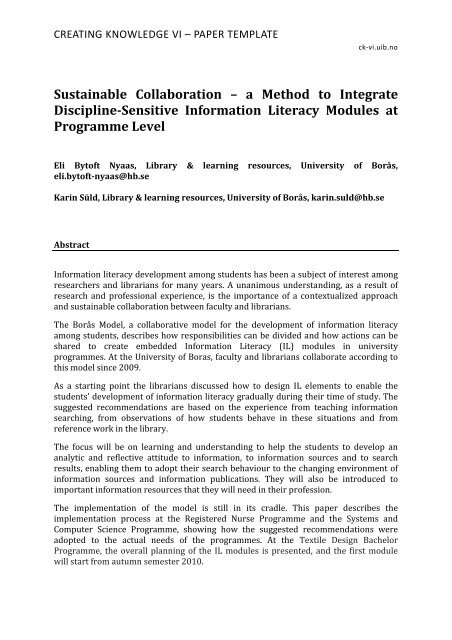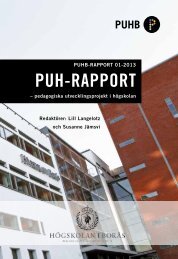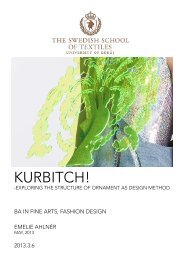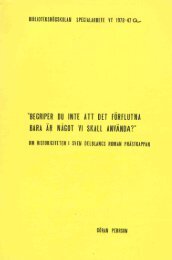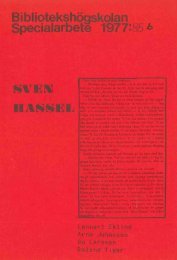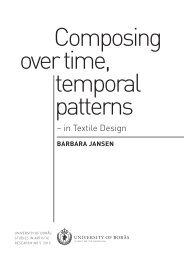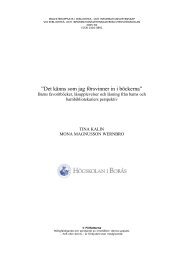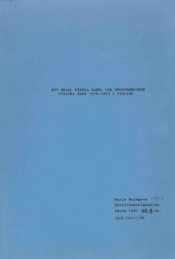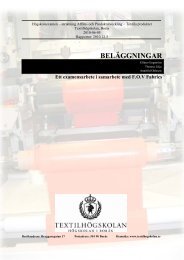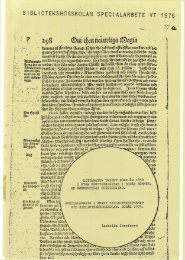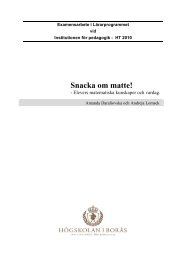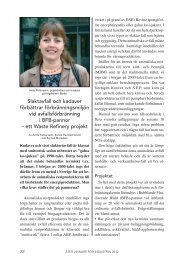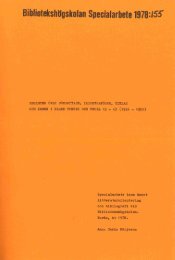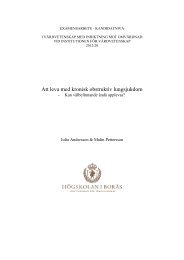Sustainable Collaboration - BADA - Högskolan i Borås
Sustainable Collaboration - BADA - Högskolan i Borås
Sustainable Collaboration - BADA - Högskolan i Borås
Create successful ePaper yourself
Turn your PDF publications into a flip-book with our unique Google optimized e-Paper software.
CREATING KNOWLEDGE VI – PAPER TEMPLATE<br />
ck‐vi.uib.no<br />
<strong>Sustainable</strong> <strong>Collaboration</strong> – a Method to Integrate<br />
DisciplineSensitive Information Literacy Modules at<br />
Programme Level<br />
Eli Bytoft Nyaas, Library & learning resources, University of <strong>Borås</strong>,<br />
eli.bytoftnyaas@hb.se<br />
Karin Süld, Library & learning resources, University of <strong>Borås</strong>, karin.suld@hb.se<br />
Abstract<br />
Information literacy development among students has been a subject of interest among<br />
researchers and librarians for many years. A unanimous understanding, as a result of<br />
research and professional experience, is the importance of a contextualized approach<br />
and sustainable collaboration between faculty and librarians.<br />
The <strong>Borås</strong> Model, a collaborative model for the development of information literacy<br />
among students, describes how responsibilities can be divided and how actions can be<br />
shared to create embedded Information Literacy (IL) modules in university<br />
programmes. At the University of Boras, faculty and librarians collaborate according to<br />
this model since 2009.<br />
As a starting point the librarians discussed how to design IL elements to enable the<br />
students’ development of information literacy gradually during their time of study. The<br />
suggested recommendations are based on the experience from teaching information<br />
searching, from observations of how students behave in these situations and from<br />
reference work in the library.<br />
The focus will be on learning and understanding to help the students to develop an<br />
analytic and reflective attitude to information, to information sources and to search<br />
results, enabling them to adopt their search behaviour to the changing environment of<br />
information sources and information publications. They will also be introduced to<br />
important information resources that they will need in their profession.<br />
The implementation of the model is still in its cradle. This paper describes the<br />
implementation process at the Registered Nurse Programme and the Systems and<br />
Computer Science Programme, showing how the suggested recommendations were<br />
adopted to the actual needs of the programmes. At the Textile Design Bachelor<br />
Programme, the overall planning of the IL modules is presented, and the first module<br />
will start from autumn semester 2010.
Introduction<br />
The University of <strong>Borås</strong> consists of six departments, offering education in Library and<br />
Information Studies, Business and Informatics, Fashion and Textile Studies, Behavioural<br />
and Education Sciences, Engineering and Health Sciences, representing disciplines with<br />
different traditions concerning scientific publications, different technical languages and<br />
different research methods.<br />
Over the years the Library has experienced a great variety of working relationships with<br />
university departments and teachers to support students’ development of information<br />
literacy. Some of these have been initiated by library friendly teachers, others were<br />
created due to intensive work by librarians. Some worked very well and were<br />
performed in a context that aroused interest among the students, others were<br />
meaningless “one shots” and in between is the whole spectrum of different relationships<br />
and attempted ways to integrate information literacy into academic curricula mentioned<br />
by McGuinness ( 2007).<br />
The <strong>Borås</strong> Model<br />
In the Strategic Plan 2009 – 2012 (<strong>Högskolan</strong> i <strong>Borås</strong> 2008) the University of <strong>Borås</strong><br />
stated the importance of information literacy development among students. The <strong>Borås</strong><br />
Model, a model of how the library and the university departments can collaborate to<br />
facilitate development of information literacy (IL) among students, is the outcome of a<br />
project run by the Library & Learning Resources and the School of Library and<br />
Information Science at the University of <strong>Borås</strong> during 2007 to 2008 (Süld & Bytoft Nyaas<br />
2008). The model is a top‐down‐model and the Rector of the University of <strong>Borås</strong> in early<br />
2009 decided that it should be implemented in all programmes at the University.<br />
2<br />
Library leadership level<br />
Teaching librarians<br />
The <strong>Borås</strong> Model:<br />
The University of <strong>Borås</strong>’ collaborative model for the<br />
development of student information literacy<br />
University leadership level<br />
Creation of prerequisites for<br />
collaboration<br />
Identify needs for teaching<br />
support in IL development<br />
Development of methods for<br />
collaboration, development of<br />
integrated courses<br />
Development of examination<br />
forms and evaluation models<br />
Faculty leadership level<br />
Directors of studies,<br />
heads of programmes,<br />
involved teachers<br />
Süld, Bytoft Nyaas & Hultgren, 2008
In order to be meaningful, information literacy training requires integration at the<br />
subject level where its development supports learning in the subject itself. It is also<br />
important that teaching is recurrent and gradually more advanced throughout the<br />
curriculum. Therefore, the overall responsibility to promote and facilitate sustainable<br />
collaboration between the university departments and the library is shared by the heads<br />
of departments and the Library Director.<br />
Together with the directors of studies and heads of programmes the librarian makes an<br />
overall planning at programme level, to identify in which courses elements of<br />
information literacy development is best needed.<br />
To promote long‐term collaboration together with gradually more advanced IL elements<br />
and the consolidation of information literacy as an integral part of education, learning<br />
outcomes is included in official course plans for the relevant courses.<br />
IL elements are weaved into programmes in ways that encourages students to view the<br />
seeking, evaluation and use of information as an important and knowledge building<br />
aspect of courses. Important information sources for the students professional work is<br />
also included.<br />
Examinations in information literacy play a significant role in student learning but focus<br />
in such examinations must be concentrated on understanding and learning and not on<br />
the measurement of skills. Examinations are also an important aspect of course<br />
evaluation and the further development of courses.<br />
The grey toned boxes in the model signal professional development. Through<br />
collaboration teachers and librarians will gain insight into each others’ professional<br />
domains which will, in turn, be fruitful for quality development in education.<br />
Implementing the <strong>Borås</strong> Model<br />
The content of the IL modules must be allowed to differ between the programmes, but<br />
essential is that IL elements must become gradually more advanced throughout the<br />
curriculum. Central information sources, as well as different aspects of the search<br />
process like describing an information need and how to use relevant search techniques<br />
and search strategies, will be included in all modules and might even, for some<br />
programmes, form the main content. Depending on the discipline, students will need to<br />
become familiar with specific information sources like business and market information<br />
databases, statistics and law. Engineers will need to search technical descriptions, rules<br />
and regulations, while art and design students have specific needs to find inspiration<br />
and ideas from images and videos.<br />
To prevent plagiarism, departments give instructions in academic writing and<br />
referencing integrated with IL modules and some departments give lessons on relevant<br />
referencing styles.<br />
Here follows a presentation of three cases, from three different programmes, to<br />
exemplify how the implementation of the <strong>Borås</strong> Model has proceeded. First, there is a<br />
description of the situation prior to the <strong>Borås</strong> Model and experiences that the suggested<br />
levels are based on. This is followed by a comparison between the IL elements in the<br />
Registered Nurse Programme and Computer and Systems Sciences Programme,<br />
3
accompanied with a description of the overall plan for the IL modules at the Textile<br />
Design Bachelor Programme.<br />
Gradually more advanced IL elements based on experience from Registered<br />
Nurse Education<br />
The recommendations for the workshops are based mainly on experience from<br />
information literacy sessions at the Registered Nurse Programme, on observations of<br />
how students perform their searches and the questions they ask in class or in the<br />
library.<br />
Prior to the Bologna Process and the development of the model, some of the teachers at<br />
the Department of Health Sciences are what McGuinness (2007) refers to as “heavy<br />
users of library instruction for their courses”. As a result, some registered nurse<br />
students were repeatedly offered library instruction in their courses. The<br />
communication between the teachers and the librarian, as well as between the teachers<br />
themselves, was however poor. As a result, the IL elements were not contextualized and<br />
often had similar focus and content. During the Bologna Process information literacy<br />
was included in learning outcomes on all levels at the School of Health Sciences at <strong>Borås</strong>,<br />
and IL modules were integrated in courses throughout the curriculum. Experience from<br />
these IL elements has been very useful both for the creation of the model and for the<br />
development of gradually more advanced IL elements.<br />
For years librarians have noticed and tried to help nursing students struggling to find<br />
relevant research articles, this continued also after the Bologna Process and occurred<br />
regularly early in their first semester. There was an outspoken demand from faculty and<br />
teachers that the nursing students, at an early stage of their education, needed to learn<br />
how to search and read scientific articles. To prepare the students for this task, the<br />
librarian gave a lecture and a workshop to guide and support the students through their<br />
search process. But students still had difficulties in performing a qualitative search and<br />
often selected a random article. Many students consulted the library, asking for help to<br />
find as they said, “any scientific article on nursing”. These students also repeatedly<br />
asked librarians for help to find textbooks and other publications from their lists of<br />
required reading. This experience resulted in the following understanding: students<br />
need to learn about publications, how to identify them, how to find them and also the<br />
different kind of information they contain. Besides, to perform a search process, from<br />
defining and describing a problem to selection and evaluation of search results, is highly<br />
advanced. Good knowledge about search techniques, information sources and about<br />
publications is required to be able to make a reflective choice.<br />
After the Bologna Process, the next IL element was integrated in a course including<br />
activity based education in the second semester. As an assignment, the students were<br />
asked to focus on a nursing situation, to formulate a query and to search one peer<br />
reviewed journal article about the problem defined. In this assignment, they were also<br />
asked to give a short description of the search process and to reflect on the search result<br />
and this assignment was examined by the librarian. The students generally managed<br />
well to focus on a specific problem related to the situation, and they managed well to<br />
write a search question. They had, however, difficulties in limiting the number of hits<br />
and often chose an article among hundreds. One student wrote in the assignment,“ The<br />
article that I chose does not cover my defined problem, but there was another situation<br />
4
…” (our translation). Again, the students generally failed to find an article relevant for<br />
their described focus, but they usually managed well to formulate a research questions.<br />
Integrated in the methods and theory course registered nursing students had a third IL<br />
element. Few students however attended the lecture and the workshops, saying that<br />
they had already attended two lectures on information searching and knew how to<br />
perform searches. This tells us how important it is to be very specific about a focus for<br />
the different IL modules, to add IL elements on gradually more advanced levels and to<br />
connect to previous IL elements. As a result the following levels were formulated:<br />
• Level one will focus on document types and analysis of information found in<br />
references and database records. Search techniques and database structure will<br />
also be discussed.<br />
• Level two will focus on citation pearl growing, alternatively on searching on<br />
medical or technical terms.<br />
• Level three will focus on discipline sensitive information or resources.<br />
• Level four will prepare the students for their work with bachelor thesis, and<br />
cover the whole spectrum of relevant information sources, techniques and<br />
strategies, including analyzing information needs, evaluating search results and<br />
citing and referencing.<br />
Information Literacy Modules according to the <strong>Borås</strong> Model – a comparison<br />
between Registered Nurse Education and Computer and Systems Science<br />
The Registered Nurse Education had IL elements in courses throughout the curriculum<br />
prior to the <strong>Borås</strong> Model. A meeting with directors of study, course coordinators and<br />
involved teachers therefore focused on how to adjust the existing elements to the <strong>Borås</strong><br />
Model. This resulted in a decision to follow the levels suggested by the librarian.<br />
Learning outcomes already existed, but to clarify the focus in each IL module for the<br />
students, criteria were added in the course handbooks.<br />
In the first IL module the focus is on publication types and analysis of information found<br />
in references and database records, on search techniques and on database structure.<br />
Most courses on the programme have long lists of required reading, consisting of a<br />
variety of document types like books, journal articles, book chapters and official papers.<br />
These are well suited for analyses of references and information about where and how<br />
to find the printed or electronic documents. A list of relevant articles for a class on<br />
reading and analyzing scientific articles was added and offered more exercise to the<br />
students.<br />
In accordance with the model, a decision was made to design an assignment to make the<br />
students analyze and reflect on the way they searched and on the search results. The<br />
assignment is corrected by the librarian. Two problems had to be considered: the large<br />
number of assignments to be examined and the communication between the students<br />
and the librarian. The solution is a self‐correcting multiple choice test on the learning<br />
management system. Beside questions about references and search operators the<br />
students are asked to search in different ways and to look for specific information in the<br />
database records.<br />
5
In the second semester the nursing students attend a microbiology course. In this course<br />
the teacher has asked the students to search a number of scientific articles about<br />
infectious risks. The students received no guidelines or requirements about this task<br />
and there was no evaluation of the result of their performed searches. Now the students<br />
were given a reference to a review article on the subject and the librarian gave a lecture<br />
on citation pearl growing. The students can use any information in the database record<br />
about this article, like words in title, abstract, subject headings or references to search<br />
additional articles on the subject. There is no assignment for this search session.<br />
The next course for these students includes activity based education. The workshop,<br />
preparing the students for the information searching assignment, starts with<br />
discussions on the students’ experience from the microbiology course. The IL module in<br />
this course focuses on the use of subject headings to perform a precise search. In the<br />
assignment the students are asked to reflect on the search process and the search result<br />
in relation to the research question. A recurrent reflection among the students this last<br />
semester was “ … when I used subject headings, all articles on the hit list were about the<br />
same subject ...”(our translation). Their search results rarely exceeded 20 hits.<br />
The nursing programme, only, has reached to the fourth level. Here the IL module was<br />
integrated in the method and theory course. In this course the students need to search<br />
information in databases and on the Web to find both academic and non‐academic<br />
sources. Critical thinking is an important part of the course, both related to search<br />
results and to evaluation of the sources. The reference tool EndNote was introduced to<br />
these students as a tool to collect and store references and to create bibliographies.<br />
Students on the Computer and Systems Science Programme have their first IL module in<br />
the first semester. Discussions with the heads of programme resulted in a decision to<br />
follow the suggested levels. These students normally have only one or two titles<br />
required reading, usually books, on each course. The teachers produced a list of classical<br />
literature as additional reading for a written assignment in the course. Different<br />
publication types are represented among the titles, books, book chapters, conference<br />
papers and journal articles, and the students are asked to analyze references, locate<br />
publications in the library or on the Web, and to analyze database records. The IL<br />
module is examined through an assignment on the learning management system similar<br />
to the one for the Registered Nurse students. These first year students were introduced<br />
to EndNote for storage of references in the EndNote Library.<br />
For these students the second IL element is weaved into a course on object oriented<br />
programming. The students are asked to choose a specific design pattern and to search<br />
scientific articles about this pattern. The design patterns have individual names and the<br />
students were asked to focus on one design pattern. During the search session the<br />
librarian noticed how the students failed to try alternative approaches when they<br />
performed their searches. Some design patterns have names like command, state and<br />
strategy, and in combination with a tendency to focus too much on a single design<br />
pattern, several students failed in finding relevant information. When discussing this<br />
with the teachers, a decision was made to introduce the citation pearl growing method<br />
even for these students, and to give them one or two articles from which they can find<br />
information to take their search process forward.<br />
6
The third IL module for the systems architect students will focus on the use of<br />
communities as a learning and communication resource. The librarian is not involved in<br />
this module.<br />
The fourth IL module will be weaved into the theory and method course but the specifics<br />
are yet to be discussed.<br />
Reactions from students, who were introduced to EndNote, were very positive.<br />
Therefore, instructions in EndNote will be integrated in all IL modules for first year<br />
students at the Registered Nurse Programme and at the Department of Business and<br />
Informatics.<br />
Textile Design Bachelor Programme<br />
The School of Textiles performs education and research within textile design, fashion<br />
design, textile science and textile and apparel business management. The teaching is<br />
mainly based on multidisciplinary collaboration, for instance between textile designers<br />
and textile engineers where creativity of art and design is combined with technical<br />
innovations. This kind of cross professional collaboration is also what many textile<br />
design students will meet in their future professional life, whether they will be working<br />
at an architect's office, an interior design office, in the public sector or in the<br />
manufacturing industry. The textile design education includes artistic, practical and<br />
theoretical elements. The majority of the students’ work, like the bachelor thesis, has<br />
main emphasis on creative, artistic and practical abilities and is most often presented in<br />
visual form with additional written texts. Traditionally written academic reports rarely<br />
or never occur.<br />
Typically, art students prefer browsing through the library shelves, scrolling through<br />
books and magazines when searching for information and inspiration rather than<br />
searching the library catalogue, a kind of visual approach instead of word based<br />
searching (Frank 1999, Stam 1995). Considering this, the way of organizing printed<br />
media within art and design may be especially important for these users. Displaying<br />
books and magazines with attractive and inspiring covers, rather than keeping them<br />
strictly organized by subject, could work as a pedagogical effort by the library. The<br />
library plan to reorganize these collections to answer to art and design students’ ways of<br />
searching information and inspiration.<br />
Discussions between the head of programme and the librarian resulted in the following:<br />
essential IL abilities are information searching on the Web, in library catalogues and subject<br />
databases, evaluation of information and communication in verbal, visual and written form.<br />
Knowledge on different kinds of publications and on image copyright is also essential. It is<br />
important for the student of the Textile Design Bachelor Programme, as well as for the<br />
professional working designer, to put their work into a historical and contemporary context.<br />
The information they might need for doing this positioning and research is information on<br />
artists, designers, companies, markets, on textiles and other kind of materials, handicrafts and<br />
artistic techniques as well as facts and images from exhibitions and fashion shows. It was<br />
decided to implement IL modules throughout the curriculum, starting autumn 2010.<br />
The first IL module, during the first year of education, will be in a course about textile<br />
and fashion design history and aesthetics. As an assignment, the students write a text<br />
about specific textile and fashion designers and their artistic methods. Information<br />
7
searching, primarily on artists’ and designers’ names, is an essential part of the study<br />
task and the instruction will focus on searching for books in library catalogues. It will<br />
also include an introduction to different publication types, referencing, citing and the<br />
evaluation of sources. As a complement, a library tour focusing on their subjects of<br />
interest and also a demonstration of selected journals and magazines will be included to<br />
give the students a visual impression of the library collection and of different<br />
publication types. To examine the IL element, a multiple choice test on the learning<br />
management system, focusing on searching and locating books, has been discussed.<br />
During the second year, an IL module will be implemented in a course that focuses on<br />
sketching techniques and development of the students’ ability to visualize their own<br />
design objects. This includes an assignment in which the students have to study<br />
sketching techniques developed by different artists, architects or designers. These<br />
techniques should be presented and discussed in relation to the student’s own<br />
techniques. The task requires information searching, both for books and for journal<br />
articles and the instruction will focus on more advanced information searching like<br />
formulating a search question, more advanced search techniques and search strategies.<br />
The students will also write a short description of their search process which will be<br />
examined by the librarian.<br />
In a course during the third year, the students work in individual projects with product<br />
development. The course emphasis is practical and it also includes theoretical elements<br />
where an IL module is appropriate. This module will focus on advanced information<br />
searching in a wide spectrum of information sources, and on evaluation of information. The<br />
content of the IL module is not yet discussed with the course coordinator, it will however<br />
answer to the information need for the theoretical elements of the course, and prepare students<br />
for the thesis process.<br />
The overall planning is done and the next step will be discussions with course<br />
coordinators and teachers about learning outcomes and the content of the IL modules.<br />
Conclusion<br />
The <strong>Borås</strong> Model has facilitated the collaboration and the development of IL modules at<br />
programme level at the University. Faculty has given a positive response to the model<br />
and the collaboration to facilitate students’ development of information literacy. Despite<br />
the willingness from all parts, there are still problems to solve and it will take time to<br />
reach mutual knowledge and understanding for each others’ professional domains. We<br />
need to build fruitful forms of collaboration to achieve this. At the Department of<br />
Nursing the head of programme, course coordinators, teachers and the librarian meet<br />
regularly to discuss their own experiences, students’ assessments and the overall<br />
outcome of the courses. This is the occasion when changes and adjustments are made,<br />
but the biggest advantage with these meetings is the coherence and the general<br />
overview it creates for all involved parts. A similar meeting was arranged with the heads<br />
of programme and the course coordinator at the Computer and Systems Science<br />
Programme with good results and the Library will promote such meetings with all<br />
programmes in the future.<br />
Another challenge to deal with is the fact that students do not develop information<br />
literacy through only a few embedded elements of information literacy during their time<br />
8
of study. It is necessary to involve all teachers and librarians to establish an ongoing<br />
process where students practice searching, evaluation and use of information<br />
throughout their education.<br />
References<br />
Frank, P. (1999). Student artists in the library: An investigation of how they use general<br />
academic libraries for. Journal of Academic Librarianship, 25(6), 445.<br />
<strong>Högskolan</strong> i <strong>Borås</strong> (2008). Forsknings och utbildningsstrategi 20092012. <strong>Borås</strong>:<br />
<strong>Högskolan</strong> i <strong>Borås</strong>.<br />
McGuinness, C. (2007). Exploring strategies for integrated information literacy.<br />
Communications in Information Literacy, 1(1), 26‐38.<br />
Nyaas, E. B., & Süld, K. (2008). Fiksa framtidens informationskompetenta studenter blir<br />
anställningsbara. Ett samarbetsprojekt mellan BHS och BLR., Mötesplats inför<br />
framtiden, 1516 oktober 2008. <strong>Borås</strong>: University of <strong>Borås</strong>. Library and Learning<br />
Resources.<br />
Stam, D. (1995). Artists and art libraries, Art Libraries Journal (Vol. 20, pp. 21‐24).<br />
9


